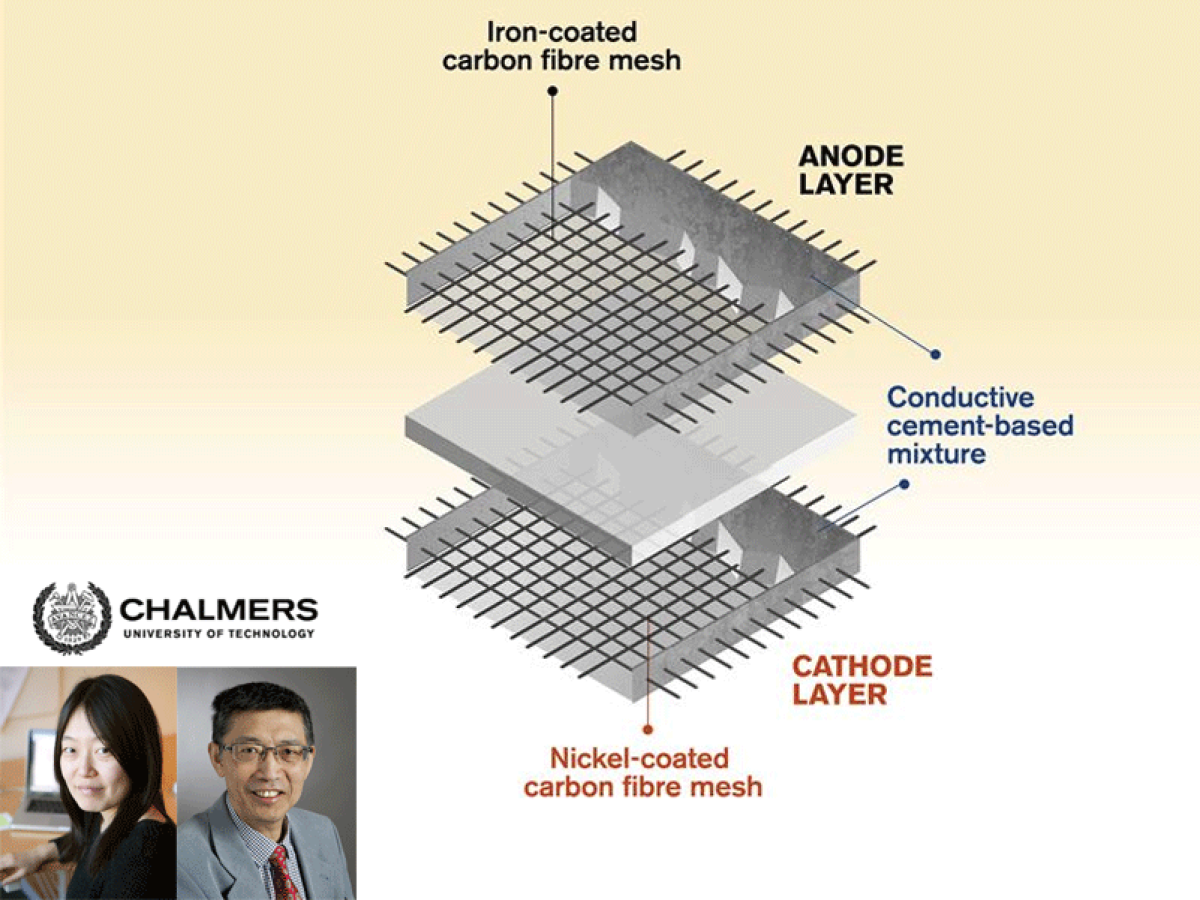Focus Around the world
This article is over 3 years old
Could concrete buildings become giant rechargeable batteries?
Sweden-based Chalmers University of Technology develops the first concept of rechargeable batteries made of cement, for sustainable building

The technology is still in the embryonic stages but if it manages to move past the current technical limitations in a not-too-distant future, the concept of rechargeable batteries made of cement might just be the solution for sustainable building.
After a number of experiments, researchers of the Architecture and Civil Engineering Department of the Chalmers University of Technology in Sweden came up with a particular cement-based mixture, adding a metal-coated (iron for anode and nickel for cathode) carbon-fibre mesh to increase the conductivity and flexural strength of the composite material.
“Results from earlier studies investigating concrete battery technology showed very low performance, so we realised we had to think out of the box, to come up with another way to produce the electrode. This particular idea that we have developed – which is also rechargeable – has never been explored before. Now we have proof of concept at lab scale”, explained Dr. Emma Zhang, who joined the research group.
The research group led by Professor Luping Tang produced a rechargeable cement battery with an average energy density (i.e. the battery’s capacity) of 7 kWh/m2, a performance that is 10 times that of earlier research.
This capacity is still very low compared to the batteries being sold in the market today, but this limitation can be overcome with additional research and experimentation, considering the size that the batteries could reach when used in buildings.
The most important quality of this Swedish technology lies in the fact that the battery is rechargeable. This means it could be used in incredibly useful ways, such as to power LEDs, supply 4G connection to remote areas, as cathodic protection against corrosion of infrastructure, or it could even be connected to solar panels to provide electricity and energy to monitoring systems.
However, this laboratory technology still poses many limitations and technical doubts that must be solved before it is placed in the market, issues like extending the life of the battery and how it will be recycled, given that buildings last a very long time and the batteries must somehow adapt to this condition. Also, even if it is the most widely used material in the world for building construction, concrete is not a sustainable material. Instead, highly sustainable building materials are what the sector needs now more than ever.
Even so, rechargeable batteries made of cement – a component of concrete – could represent a solution to the energy storage problem, because if used in buildings, their size would be gigantic. Let’s just wait and see if research will achieve even more extraordinary results.
After a number of experiments, researchers of the Architecture and Civil Engineering Department of the Chalmers University of Technology in Sweden came up with a particular cement-based mixture, adding a metal-coated (iron for anode and nickel for cathode) carbon-fibre mesh to increase the conductivity and flexural strength of the composite material.
“Results from earlier studies investigating concrete battery technology showed very low performance, so we realised we had to think out of the box, to come up with another way to produce the electrode. This particular idea that we have developed – which is also rechargeable – has never been explored before. Now we have proof of concept at lab scale”, explained Dr. Emma Zhang, who joined the research group.
The research group led by Professor Luping Tang produced a rechargeable cement battery with an average energy density (i.e. the battery’s capacity) of 7 kWh/m2, a performance that is 10 times that of earlier research.
This capacity is still very low compared to the batteries being sold in the market today, but this limitation can be overcome with additional research and experimentation, considering the size that the batteries could reach when used in buildings.
The most important quality of this Swedish technology lies in the fact that the battery is rechargeable. This means it could be used in incredibly useful ways, such as to power LEDs, supply 4G connection to remote areas, as cathodic protection against corrosion of infrastructure, or it could even be connected to solar panels to provide electricity and energy to monitoring systems.
However, this laboratory technology still poses many limitations and technical doubts that must be solved before it is placed in the market, issues like extending the life of the battery and how it will be recycled, given that buildings last a very long time and the batteries must somehow adapt to this condition. Also, even if it is the most widely used material in the world for building construction, concrete is not a sustainable material. Instead, highly sustainable building materials are what the sector needs now more than ever.
Even so, rechargeable batteries made of cement – a component of concrete – could represent a solution to the energy storage problem, because if used in buildings, their size would be gigantic. Let’s just wait and see if research will achieve even more extraordinary results.


